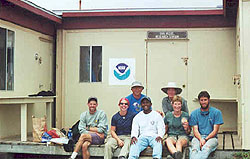| |

The new San Miguel Island Research Station (top) replaces the former structure of
modified cargo containers (below).
 |
CALIFORNIA CURRENT ECOSYSTEM PROGRAM:
San Miguel Island Research Station
A new research station at San Miguel Island, California, is being constructed
cooperatively by NOAA and the National Park Service. The research station
supports the long-term monitoring programs of NOAA and the National Park
Service. The station replaces the former structure of modified cargo containers,
and though not completely finished, does have a completed exterior that
was built prior to the onset of winter rains.
NMML has monitored pinniped populations on San Miguel Island for over 30
years. Since enactment of the Marine Mammal Protection Act, this research
has documented growth and recovery of the pinniped populations, the effects
of El Niño events on pinnipeds, long-term movements of elephant seals,
impacts of pollutants on premature birthing of sea lions, and the role
of disease in population control.
The National Park Service has used the station to support various researchers,
including those studying the endangered and endemic island fox and anthropologists
exploring middens which record the activities of early humans for over
10,000 years. The station is also used as a stopover by park guests on
their 6-mile walk to the Point Bennett rookery on the island. The interaction
with the public provides an opportunity to showcase NOAA and its research program.
By Robert DeLong.
Gray Whale Research
From 2 October to 5 November 2003, 12 gray whale surveys were conducted
in the western Strait of Juan de Fuca and off the northern Washington coast.
These surveys covered 143 nautical miles (nmi) along the Washington coast
and 95 nmi in the Strait of Juan de Fuca. Nine gray whales were sighted
and photographed off the Washington coast and five gray whales were photographed
in the Strait of Juan de Fuca. Further surveys were curtailed due to bad
weather. The photographic surveys are used to support analysis of survival
and abundance of gray whales in the Pacific Coast feeding aggregation.
By Merrill Gosho.
Washington/Oregon Steller Sea Lion Research
Dedicated resight surveys of Steller sea lions have been conducted from
northern California to northern Washington State since 2002 to record the
distribution and abundance of tagged and branded Steller sea lions. The
purpose of these surveys is to compile information about distribution and
to generate survival estimates for the species in this region.
Between 2 October and 5 November 2003, resight surveys were conducted along
the northern coast of Washington. A total of nine previously branded sea
lions were observed at Tatoosh Island, Carroll Island, and near Cape Alava.
These sea lions consisted of seven that were branded at Rogue Reef, Oregon,
and two at Cape Saint George in northern California.
A series of three resight surveys were conducted in northern California
and Oregon between 20 October and 13 December 2003. During this time,
62 individual branded Steller sea lions were observed in October, 43 in
November, and 39 in December. Most were observed at three sites in Oregon
including Cascade Head, Cape Arago, and the Sea Lion Caves.
By Patrick Gearin.
>>>continued

|
 |
quarterly Oct-Dec 2003 sidebar
AFSC Quarterly
Research Reports
Oct-Nov-Dec 2003
Contents
Feature
Auke Bay Lab
National Marine
Mammal Lab
RACE Division
REFM Division
Quarterly Index
Quarterly Home
|

